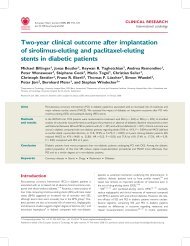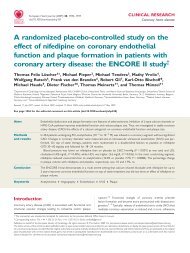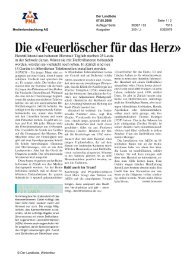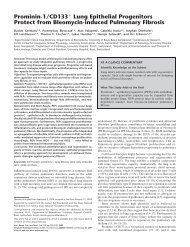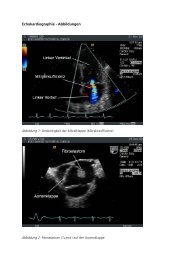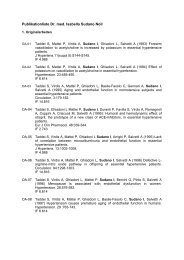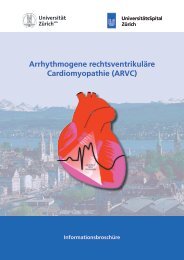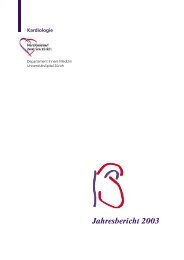PDF (508 KB)
PDF (508 KB)
PDF (508 KB)
Create successful ePaper yourself
Turn your PDF publications into a flip-book with our unique Google optimized e-Paper software.
Cardiopulmonary Imaging • Original Research<br />
Tatusagami et al.<br />
64-MDCT Coronary Angiography<br />
Cardiopulmonary Imaging<br />
Original Research<br />
FOCUS ON:<br />
Evaluation of a Body Mass Index–<br />
Adapted Protocol for Low-Dose<br />
64-MDCT Coronary Angiography<br />
with Prospective ECG Triggering<br />
Fuminari Tatsugami 1<br />
Lars Husmann 1<br />
Bernhard A. Herzog 1<br />
Nina Burkhard 1<br />
Ines Valenta 1<br />
Oliver Gaemperli 1<br />
Philipp A. Kaufmann 1,2<br />
Tatsugami F, Husmann L, Herzog BA, et al.<br />
Keywords: adapted scanning protocol, body mass index,<br />
coronary CT angiography, image noise, vessel<br />
opacification<br />
DOI:10.2214/AJR.08.1390<br />
OBJECTIVE. Because an increase in body mass index (weight in kilograms divided by<br />
height squared in meters) confers higher image noise at coronary CT angiography, we evaluated<br />
a body mass index–adapted scanning protocol for low-dose 64-MDCT coronary angiography<br />
with prospective ECG triggering.<br />
Subjects AND METHODS. One hundred one consecutively registered patients underwent<br />
coronary CTA with prospective ECG triggering with a fixed contrast protocol (80<br />
mL of iodixanol, 50-mL saline chaser, flow rate of 5 mL/s). Tube voltage (range, 100–120<br />
kV) and current (range, 450–700 mA) were adapted to body mass index. Attenuation was<br />
measured, and contrast-to-noise ratio was calculated for the proximal right coronary artery<br />
and left main coronary artery. Image noise was determined for each patient as the SD of attenuation<br />
in the ascending aorta.<br />
RESULTS. Body mass index ranged from 18.2 to 38.8, and mean effective radiation dose<br />
from 1.0 to 3.2 mSv. There was no correlation between body mass index and image noise (r =<br />
0.11, p = 0.284), supporting the validity of the body mass index–adapted scanning protocol.<br />
However, body mass index was inversely correlated with vessel attenuation (right coronary<br />
artery, r = –0.45, p < 0.001; left main coronary artery, r = –0.47, p < 0.001) and contrast-tonoise<br />
ratio (right coronary artery, r = –0.39, p < 0.001; left main coronary artery, r = –0.37,<br />
p < 0.001).<br />
CONCLUSION. Use of the proposed body mass index–adapted scanning parameters<br />
results in similar image noise regardless of body mass index. Increased bolus dilution due to<br />
larger blood volume may account for the decrease in contrast-to-noise ratio and vessel attenuation<br />
in patients with higher body mass index, but the contrast bolus was not adapted to body<br />
mass index in this study.<br />
Received June 13, 2008; accepted after revision<br />
September 27, 2008.<br />
Supported by grants from the Swiss National Science<br />
Foundation (SNSF professorship grant PP00A-114706)<br />
and the Zurich Center of Integrative Human Physiology.<br />
F. Tatsugami and L. Husmann contributed equally to this<br />
work.<br />
1 Departments of Medical Radiology and Nuclear<br />
Cardiology and the Cardiovascular Center, University<br />
Hospital Zurich, Raemistrasse 100, NUK C 32, CH-8091<br />
Zurich, Switzerland. Address correspondence to<br />
P. A. Kaufmann (pak@usz.ch).<br />
2 Zurich Center for Integrative Human Physiology,<br />
University of Zurich, Zurich, Switzerland.<br />
AJR 2009; 192:635–638<br />
0361–803X/09/1923–635<br />
© American Roentgen Ray Society<br />
C<br />
oronary CT angiography (CTA)<br />
has been found to have high diagnostic<br />
accuracy in the detection<br />
of coronary artery disease<br />
[1–4]. However, high effective radiation exposure<br />
of 9.4–21.4 mSv [5, 6] is a concern.<br />
Previous scanning protocols entailed use of<br />
the helical scanning mode with retrospective<br />
ECG gating and fixed tube voltage and current<br />
regardless of the patients’ body mass<br />
index (BMI) (weight in kilograms divided by<br />
height squared in meters). Scanning protocols<br />
involving prospective ECG triggering<br />
have been found feasible. With these protocols<br />
effective radiation dose can be reduced<br />
to 2.1–2.8 mSv [7, 8]. Coronary CTA with<br />
prospective ECG triggering results in a less<br />
effective radiation dose than with the previous<br />
helical mode because radiation is admin-<br />
istered only in the end-diastolic phase rather<br />
than throughout the cardiac cycle. Furthermore,<br />
BMI-adapted tube voltage and tube<br />
current protocols have been introduced to<br />
low-dose scanning protocols [7, 8].<br />
Because an increase in BMI confers higher<br />
image noise at CT, adaptation of tube voltage<br />
and tube current to individual BMI has been<br />
suggested [9–12]. The goals are to avoid decreased<br />
vessel attenuation and increased image<br />
noise in patients with a high BMI and to<br />
avoid unnecessary overexposure of patients<br />
with a low BMI. However, to our knowledge,<br />
no BMI-adapted scanning protocol for coronary<br />
CTA with prospective ECG triggering<br />
has been evaluated. The purpose of this study<br />
was to evaluate a BMI-adapted scanning protocol<br />
for low-dose 64-MDCT coronary angiography<br />
with prospective ECG triggering.<br />
AJR:192, March 2009 635
Tatusagami et al.<br />
Subjects and Methods<br />
Patients<br />
The study protocol was approved by the<br />
institutional review board, and written informed<br />
consent was obtained. One hundred one consecutively<br />
registered patients (36 women, 65 men;<br />
mean age, 57.2 ± 12.2 years; range, 20–77 years)<br />
were prospectively enrolled. Exclusion criteria for<br />
CT were hypersensitivity to iodinated contrast<br />
agent, renal insufficiency (creatinine level > 150<br />
µmol/L [> 1.7 mg/dL]), nonsinus rhythm, and<br />
hemo dynamic instability. Patients were referred<br />
because of suspicion of coronary artery disease (n =<br />
92) based on at least one of the following symptoms:<br />
dyspnea (n = 11), typical angina pectoris (n = 12),<br />
atypical chest pain (n = 51), pathologic exercise<br />
test or ECG result (n = 36), high cardiovascular<br />
risk (n = 4). Nine patients with known coronary<br />
artery disease were referred for stent (n = 5) or<br />
bypass (n = 1) or for follow-up after myocardial<br />
infarction (n = 3).<br />
CT Data Acquisition and Postprocessing<br />
All patients received a single dose of 2.5 mg<br />
sublingual isosorbide dinitrate (Isoket, Schwarz<br />
Pharma) 2 minutes before acquisition. In addition,<br />
5–20 mg IV metoprolol (Beloc, AstraZeneca) was<br />
administered before the coronary CTA examination<br />
if necessary to achieve a target heart rate<br />
less than 65 beats/min. A fixed contrast protocol<br />
was used for all patients. A bolus of 80 mL iodixanol<br />
(Visipaque 320, 320 mg/mL, GE Healthcare)<br />
was continuously injected into an antecubital vein<br />
through an 18-gauge catheter at a flow rate of 5<br />
mL/s and followed by 50 mL saline solution. Bolus<br />
tracking was performed with a region of interest<br />
(ROI) placed into the ascending aorta.<br />
All coronary CTA examinations (LightSpeed<br />
VCT XT scanner, GE Healthcare) were performed<br />
with prospective ECG triggering [13] according<br />
to a commercially available protocol (SnapShot<br />
Pulse, GE Healthcare). The scanning parameters<br />
were as follows: slice acquisition, 64 × 0.625 mm;<br />
smallest x-ray window (75% of the R-R cycle);<br />
z-coverage value of 40 mm with an increment of 35<br />
mm; gantry rotation time 350 milliseconds. Tube<br />
voltage and tube current were adapted to individual<br />
BMI according to the protocol shown in Table 1.<br />
Scanning was performed from below the tracheal<br />
bifurcation to the diaphragm in three- to five-scan<br />
blocks. The effective radiation dose of coronary<br />
CTA was calculated as the product of the dose–<br />
length product and a conversion coefficient for<br />
the chest (k = 0.017 mSv/mGy·cm) [14]. Axial<br />
images for contrast-to-noise ratio (CNR) calculations<br />
were reconstructed with a slice thickness<br />
of 0.6 mm and a medium soft-tissue convolution<br />
kernel (stand ard). All images were transferred to<br />
an external workstation (AW 4.4, GE Healthcare).<br />
CT Data Analysis<br />
All parameters were determined by one reader,<br />
who had 4 years of experience in cardiovascular<br />
radiology. Calculation of CNR in the proximal right<br />
(RCA) and left main (LMA) coronary arteries was<br />
performed as previously described [15, 16] and<br />
comprised the following steps. First, attenuation<br />
was measured in an ROI in the proximal RCA and<br />
the LMA. ROIs were drawn to be as large as<br />
possible; calcifications, plaques, and stenoses were<br />
carefully avoided. Vessel contrast was calculated<br />
as the difference in mean attenu ation between the<br />
contrast-enhanced vessel lumen and the adjacent<br />
perivascular tissue. Second, image noise was<br />
determined as the SD of the attenuation value in an<br />
ROI placed in the ascending aorta. Third, CNR was<br />
calculated as the ratio of vessel contrast to noise.<br />
Overall image quality was assessed on a 5-point<br />
scale as previously reported [7] (1, excellent image<br />
quality; 2, blurring of the vessel wall; 3, mild<br />
artifacts; 4, severe artifacts; 5, nonevaluative).<br />
Statistical Analysis<br />
Quantitative variables were expressed as mean ±<br />
SD and categoric variables as frequencies, or percentages.<br />
SPSS software (version 15.0, SPSS) was<br />
used for statistical testing. Pearson's cor relation<br />
analysis was performed to compare BMI with<br />
image noise, contrast enhancement, and CNR of<br />
the LMA and RCA. The relation between BMI and<br />
TABLE 1: Protocol for Body Mass Index–Adapted Scanning Protocol<br />
for Low-Dose 64-MDCT Coronary Angiography with Prospective<br />
ECG Triggering<br />
Body Mass Index Voltage (kV) Current (mA)<br />
< 22.5 100 450<br />
22.5–24.9 100 500<br />
25–27.4 120 550<br />
27.5–29.9 120 600<br />
30–40 120 650<br />
> 40 120 700<br />
overall image quality was analyzed with Spear man’s<br />
rank correlation coefficient. A value of p < 0.05<br />
was considered to indicate statistical significance.<br />
Results<br />
CT was successfully performed without<br />
complications on all 101 patients. Five patients<br />
were excluded from analysis because of<br />
hypoplasia of the RCA (n = 3) or severe motion<br />
artifacts in the proximal RCA (n = 2).<br />
The mean dose–length product at coronary<br />
CTA was 120.8 ± 40.0 mGy·cm (range, 58.3–<br />
189.4 mGy·cm), resulting in an estimated<br />
mean applied radiation dose of 2.1 ± 0.7 mSv<br />
(range, 1.0–3.2 mSv). BMI was significantly<br />
related to effective radiation dose (p < 0.001).<br />
The mean BMI of the study population<br />
was 25.7 ± 4.3 (range, 18.2–38.8). Two patients<br />
(2%) were underweight (BMI < 18.5),<br />
47 patients (47%) were of normal weight<br />
(BMI, 18.5–24.9), 38 patients (38%) were<br />
overweight (BMI, 25–29.9), and 14 patients<br />
(14%) were obese (BMI > 30).<br />
The mean attenuation of the RCA was<br />
404.1 ± 112.1 HU (range, 119–747 HU), and<br />
the mean attenuation of the LMA was 406.6 ±<br />
115.7 HU (range, 140–666 HU). The mean<br />
attenuation of the perivascular tissue adjacent<br />
to the RCA was –68.3 ± 20.8 HU (range, –140<br />
to –19 HU), and of that adjacent to the LMA<br />
was –60.1 ± 23.8 HU (range, –104 to –7 HU).<br />
The SD of attenuation in the ascending aorta<br />
was 34.3 ± 6.4 HU (range, 20.8–55.7 HU).<br />
The calculated CNR in the RCA was 14.1 ±<br />
4.0 (range, 5.4–28.2), and that in the LMA<br />
was 13.9 ± 3.9 (range, 6.5–29.8).<br />
There was no significant correlation between<br />
BMI and image noise (r = 0.11, p =<br />
0.284) (Fig. 1), supporting the validity of the<br />
Image Noise (HU)<br />
60 r = 0.11<br />
p = 0.28<br />
50<br />
40<br />
30<br />
20<br />
20<br />
25 30 35<br />
Body Mass Index<br />
Fig. 1—Linear regression plot of image noise against<br />
body mass index shows no correlation. Solid line =<br />
mean; dashed lines = 95% individual prediction<br />
interval.<br />
40<br />
636 AJR:192, March 2009
64-MDCT Coronary Angiography<br />
BMI-adapted scanning protocol. However,<br />
BMI correlated inversely with vessel attenuation<br />
(RCA, r = –0.45, p < 0.001; LMA, r =<br />
–0.47, p < 0.001) (Fig. 2) and CNR (RCA, r =<br />
–0.39, p < 0.001; LMA, r = –0.37, p < 0.001).<br />
Figures 3 and 4 show that as a result of the<br />
BMI-adapted protocol, noise in patients with<br />
a low BMI (Fig. 3) was similar to that in patients<br />
with a high BMI (Fig. 4). Vessel attenuation<br />
in the LMA and aorta, however, was<br />
lower in patients with a high BMI.<br />
In 101 patients, a total of 1,376 coronary<br />
artery segments with a diameter of 1.5 mm<br />
or greater were evaluated for image quality.<br />
Among these segments, 1,312 (95.4%) were<br />
of diagnostic image quality (score 1–3), and<br />
64 segments (4.6%) were nondiagnostic<br />
(score 4–5). The mean image quality per patient<br />
was 1.9 ± 0.6 (range, 1.0–3.9) and did<br />
not correlate with BMI.<br />
Vessel Attenuation in Right<br />
Coronary Artery (HU)<br />
700<br />
600<br />
500<br />
400<br />
300<br />
200<br />
100<br />
0<br />
20<br />
25 30 35<br />
Body Mass Index<br />
r = −0.45<br />
p < 0.001<br />
40<br />
A<br />
Vessel Attenuation in Left<br />
Main Coronary Artery (HU)<br />
700<br />
600<br />
500<br />
400<br />
25 30 35<br />
Body Mass Index<br />
r = −0.47<br />
p < 0.001<br />
Fig. 2—Linear regression plots.<br />
A and B, Plots of vessel attenuation in right (A) and left main (B) coronary arteries against body mass index show<br />
significant negative dependency. Solid line = mean; dashed lines = 95% individual prediction interval.<br />
300<br />
200<br />
100<br />
0<br />
20<br />
40<br />
B<br />
Discussion<br />
This study is the first, to our knowledge,<br />
evaluation of a BMI-adapted scanning protocol<br />
for coronary CTA with prospective ECG<br />
triggering. Similar image noise regardless of<br />
BMI was observed in all patients, supporting<br />
the validity of adaptation of the protocol to<br />
BMI. However, despite successful compensation<br />
for the effect of higher BMI on image<br />
noise, CNR and vessel attenuation decreased<br />
in patients with a higher BMI.<br />
BMI is a known factor influencing image<br />
quality in CT examinations [9, 10, 12]. In particular,<br />
in CTA, a higher BMI unfavorably affects<br />
CNR, supposedly by decreasing arterial<br />
attenuation while increasing image noise [9,<br />
11]. To compensate for the latter, adaptation of<br />
scanning parameters such as tube voltage and<br />
tube current to BMI has been suggested [11,<br />
12]. Because the resulting image noise was<br />
similar in all patients regardless of BMI, the<br />
results of this study document that our proposed<br />
BMI-adapted parameters proved successful<br />
in compensating for BMI. However,<br />
an increase in BMI was paralleled by a decrease<br />
in coronary artery attenuation and<br />
therefore by a decrease in CNR. Because the<br />
contrast bolus was not adapted to BMI, we<br />
have to assume that the fixed contrast material<br />
protocol might have contributed to this effect.<br />
This finding is in line with the finding by Bae<br />
et al. [17] that image attenuation is affected<br />
by BMI. The lowest attenuation values are<br />
found in obese patients and the highest values<br />
in patients of normal weight.<br />
Several patient- and injection-related factors,<br />
such as BMI; cardiac output; the volume,<br />
Fig. 3—60-year-old man with body mass index of<br />
21.3. Axial CT images obtained at 100 kV and 450 mA<br />
show ascending aorta and proximal left main artery<br />
with image noise of 33.1 HU and vessel attenuation<br />
of 492 HU.<br />
con centration, and type of contrast medium;<br />
and the saline flush, have been identified as<br />
having an influence on contrast enhancement<br />
[17]. As in our study, scanning parameters<br />
have been successfully adapted to individual<br />
BMI. The result is an equal noise level<br />
throughout the range of BMIs. Because all of<br />
the aforementioned injection-related parameters<br />
were kept constant for our whole study<br />
population, the observed variation in attenuation<br />
is probably related to individual differences<br />
in bolus dilution in blood. Higher circulating<br />
blood volumes have been associated<br />
with lower coronary artery attenuation [18].<br />
The proposed BMI-adapted scanning protocol<br />
not only achieves similar image noise<br />
for all sizes of patients but also results in a<br />
reduced radiation dose in patients with a low<br />
Fig. 4—53-year-old man with body mass index of<br />
32.0. Axial CT images obtained at 120 kV and 650 mA<br />
show ascending aorta and proximal left main artery<br />
with image noise of 34.0 HU and vessel attenuation<br />
of 286 HU. Patient has different body mass index from<br />
patient in Figure 3, but image noise is similar to that<br />
in Figure 3.<br />
BMI. Several approaches have been focused<br />
on reducing the effective radiation dose of<br />
coronary CTA examinations by modulating<br />
the tube voltage or tube current settings. The<br />
adaptation of tube current settings to body<br />
weight proved useful, resulting in constant<br />
image noise and reducing radiation dose<br />
11.6–26.3% [9, 19]. Adaptation of tube voltage,<br />
however, also is important for radiation<br />
dose reduction because the dose alters with<br />
the square of tube voltage [12]. Leschka et<br />
al. [6] investigated the quality of images of<br />
the coronary arteries using scanning protocols<br />
with 100 kV and 120 kV. They found<br />
that the protocol with 100 kV was feasible in<br />
patients of normal weight, yielding diagnostic<br />
image quality and a significant reduction<br />
of radiation dose.<br />
AJR:192, March 2009 637
Tatusagami et al.<br />
In coronary CTA with prospective ECG<br />
triggering, radiation is administered only<br />
during the end-diastolic phase of the R-R<br />
cycle rather than throughout the entire cardiac<br />
cycle [13]. Combining prospective ECG<br />
triggering for coronary CTA with BMIadapted<br />
scanning parameters allows a substantial<br />
reduction in radiation dose [7, 8].<br />
The mean effective radiation dose in the<br />
present study (2.1 ± 0.7 mSv) was much lower<br />
than in previous reports [5, 6] of retrospective<br />
ECG gating without a BMI-adapted<br />
scanning protocol (9.4–21.4 mSv).<br />
We acknowledge the following limitations.<br />
First, the dose of contrast material was<br />
not adapted to BMI, as suggested in previous<br />
reports [11, 17]. However, use of only a fixed<br />
amount of contrast material enabled us to<br />
evaluate the influence of BMI on image noise<br />
and coronary vessel attenuation. Second,<br />
coronary attenuation and CNR were selectively<br />
evaluated in the proximal RCA and<br />
LMA. Distal segments were not evaluated<br />
because the small diameters of distal segments<br />
do not allow placement of an ROI<br />
without including parts of the vessel wall and<br />
adjacent tissue, thus causing partial volume<br />
effects. Finally, BMI may not be an exact estimation<br />
of body mass at the level of the<br />
heart. The physique differs, for example, in<br />
men and women in the upper and lower parts<br />
of the thorax, which might have been an additional<br />
reason for the lack of correlation between<br />
BMI and image noise in this study.<br />
We conclude that at coronary CTA with<br />
prospective ECG triggering, a BMI-adapted<br />
scanning protocol yields images with similar<br />
noise regardless of BMI. Increased bolus dilution<br />
due to larger blood volume might have<br />
accounted for a decrease in CNR and vessel<br />
attenuation in patients with a higher BMI in<br />
this study because the contrast material bolus<br />
was not adapted.<br />
References<br />
1. Mollet NR, Cademartiri F, van Mieghem CA, et<br />
al. High-resolution spiral computed tomography<br />
coronary angiography in patients referred for diagnostic<br />
conventional coronary angiography. Circulation<br />
2005; 112:2318–2323<br />
2. Raff GL, Gallagher MJ, O’Neill WW, et al. Diagnostic<br />
accuracy of noninvasive coronary angiography<br />
using 64-slice spiral computed tomography.<br />
J Am Coll Cardiol 2005; 46:552–557<br />
3. Scheffel H, Alkadhi H, Plass A, et al. Accuracy of<br />
dual-source CT coronary angiography: first experience<br />
in a high pre-test probability population<br />
without heart rate control. Eur Radiol 2006; 16:<br />
2739–2747<br />
4. Husmann L, Schepis T, Scheffel H, et al. Comparison<br />
of diagnostic accuracy of 64-slice computed<br />
tomography coronary angiography in patients<br />
with low, intermediate, and high cardio vascular<br />
risk. Acad Radiol 2008; 15:452–461<br />
5. Hausleiter J, Meyer T, Hadamitzky M, et al. Radiation<br />
dose estimates from cardiac multislice<br />
computed tomography in daily practice: impact of<br />
different scanning protocols on effective dose estimates.<br />
Circulation 2006; 113:1305–1310<br />
6. Leschka S, Stolzmann P, Schmid FT, et al. Low<br />
kilovoltage cardiac dual-source CT: attenuation,<br />
noise, and radiation dose. Eur Radiol 2008; 18:<br />
1809–1817<br />
7. Husmann L, Valenta I, Gaemperli O, et al. Feasibility<br />
of low-dose coronary CT angiography: first<br />
experience with prospective ECG-gating. Eur<br />
Heart J 2008; 29:191–197<br />
8. Earls JP, Berman EL, Urban BA, et al. Prospectively<br />
gated transverse coronary CT angiography<br />
versus retrospectively gated helical technique:<br />
improved image quality and reduced radiation<br />
dose. Radiology 2008; 246:742–753<br />
9. Jung B, Mahnken AH, Stargardt A, et al. Individually<br />
weight-adapted examination protocol in retrospectively<br />
ECG-gated MSCT of the heart. Eur<br />
Radiol 2003; 13:2560–2566<br />
10. Irie T, Inoue H. Individual modulation of the tube<br />
current-seconds to achieve similar levels of image<br />
noise in contrast-enhanced abdominal CT. AJR<br />
2005; 184:1514–1518<br />
11. Husmann L, Leschka S, Boehm T, et al. Influence<br />
of body mass index on coronary artery opacification<br />
in 64-slice CT angiography [in German].<br />
Rofo 2006; 178:1007–1013<br />
12. Huda W, Scalzetti EM, Levin G. Technique factors<br />
and image quality as functions of patient<br />
weight at abdominal CT. Radiology 2000; 217:<br />
430–435<br />
13. Hsieh J, Londt J, Vass M, et al. Step-and-shoot<br />
data acquisition and reconstruction for cardiac x-<br />
ray computed tomography. Med Phys 2006; 33:<br />
4236–4248<br />
14. Einstein AJ, Moser KW, Thompson RC, et al. Radiation<br />
dose to patients from cardiac diagnostic<br />
imaging. Circulation 2007; 116:1290–1305<br />
15. Lembcke A, Wiese TH, Schnorr J, et al. Image<br />
quality of noninvasive coronary angiography using<br />
multislice spiral computed tomography and<br />
electron-beam computed tomography: intraindividual<br />
comparison in an animal model. Invest Radiol<br />
2004; 39:357–364<br />
16. Achenbach S, Giesler T, Ropers D, et al. Comparison<br />
of image quality in contrast-enhanced<br />
coronary-artery visualization by electron beam<br />
tomography and retrospectively electrocardiogram-gated<br />
multislice spiral computed tomography.<br />
Invest Radiol 2003; 38:119–128<br />
17. Bae KT, Seeck BA, Hildebolt CF, et al. Contrast<br />
enhancement in cardiovascular MDCT: effect of<br />
body weight, height, body surface area, body<br />
mass index, and obesity. AJR 2008; 190:777–<br />
784<br />
18. Husmann L, Alkadhi H, Boehm T, et al. Influence<br />
of cardiac hemodynamic parameters on coronary<br />
artery opacification with 64-slice computed tomography.<br />
Eur Radiol 2006; 16:1111–1116<br />
19. Mahnken AH, Wildberger JE, Simon J, et al. Detection<br />
of coronary calcifications: feasibility of<br />
dose reduction with a body weight-adapted examination<br />
protocol. AJR 2003; 181:533–538<br />
638 AJR:192, March 2009




